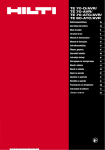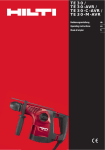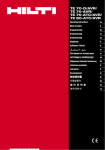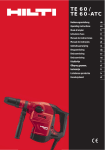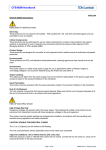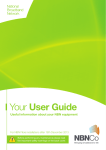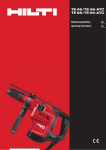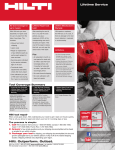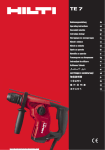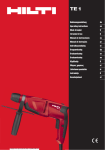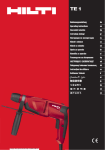Download ORIGINAL OPERATING INSTRUCTIONS TE 70
Transcript
ORIGINAL OPERATING INSTRUCTIONS TE 70-D/AVR rotary hammer TE 70-AVR, TE 70-ATC/AVR, TE 80-ATC/AVR combihammer en It is essential that the operating instructions are read before the power tool is operated for the first time. In these operating instructions, the designation “the power tool” always refers to the TE 70-D/AVR rotary hammer or TE 70-AVR, TE 70-ATC/AVR or TE 80-ATC/AVR combihammer. Always keep these operating instructions together with the power tool. TE 70-ATC/AVR and TE 80-ATC/AVR 1 Ensure that the operating instructions are with the power tool when it is given to other persons. Contents 1 General information 2 Description 3 Insert tools, accessories 4 Technical data 5 Safety instructions 6 Before use 7 Operation 8 Care and maintenance 9 Troubleshooting 10 Disposal 11 Manufacturer’s warranty - tools 12 EC declaration of conformity (original) Page 1 2 4 4 6 8 8 10 11 12 12 12 1 These numbers refer to the corresponding illustrations. The illustrations can be found on the fold-out cover pages. Keep these pages open while studying the operating instructions. @ Function selector switch ; Control switch lock = Control switch % Supply cord & Button for 50% power reduction (only ATC combihammers) ( Side handle ) Chuck + Dust shield § Insert tool unlocking device / Service indicator : Reduced-power indicator (only ATC combihammers) TE 70-D/AVR and TE 70/AVR 2 @ Function selector switch (only combihammers) ; Control switch lock (only combihammers) = Control switch % Supply cord ( Side handle ) Chuck + Dust shield § Insert tool unlocking device / Service indicator 1 General information 1.1 Safety notices and their meaning DANGER Draws attention to imminent danger that will lead to serious bodily injury or fatality. WARNING Draws attention to a potentially dangerous situation that could lead to serious personal injury or fatality. CAUTION Draws attention to a potentially dangerous situation that could lead to slight personal injury or damage to the equipment or other property. NOTE Draws attention to an instruction or other useful information. 1.2 Explanation of the pictograms and other information Warning signs General warning Warning: electricity Warning: hot surface 1 Printed: 16.05.2014 | Doc-Nr: PUB / 5150803 / 000 / 01 Obligation signs Wear eye protection en Wear a hard hat Wear ear protection Wear protective gloves Wear breathing protection Diameter Chiseling Chisel position adjustment Double insulated Hammer drilling Location of identification data on the power tool The type designation and serial number can be found on the type identification plate on the machine or tool. Make a note of this data in your operating instructions and always refer to it when making an enquiry to your Hilti representative or service department. Symbols Read the operating instructions before use Revolutions per minute Returning materials for recycling Volts Amps Type: Generation: 03 Serial no.: Watts Alternating current Hertz Rated speed under no load 2 Description 2.1 Use of the product as directed The power tool is an electrically-powered rotary hammer (TE 70-D/AVR) or combihammer with pneumatic hammering mechanism. The ATC (Active Torque Control) function incorporated in the TE 70‑ATC/AVR and TE 80‑ATC/AVR provides greater operating comfort while drilling The power tool is designed for drilling in concrete, masonry, metal and wood and can also be used for chiseling (not the TE 70-D/AVR). The power tool may be used to work only on non-flammable materials. Under certain conditions, the power tool is suitable for use for mixing (see “Tools, accessories” and “Operation”). Working on materials hazardous to the health (e.g. asbestos) is not permissible. Observe national health and safety requirements. The power tool is designed for professional use and may be operated, serviced and maintained only by trained, authorized personnel. This personnel must be informed of any special hazards that may be encountered. The power tool and its ancillary equipment may present hazards when used incorrectly by untrained personnel or when used not as directed. The working environment may be as follows: construction site, workshop, renovation, conversion or new construction. The power tool may be used only in a dry environment. Do not use the power tool where there is a risk of fire or explosion. The power tool may be operated only when connected to a power supply providing a voltage and frequency in compliance with the information given on its type identification plate. Modification of the power tool or tampering with its parts is not permissible. To avoid the risk of injury, use only genuine Hilti accessories and insert tools. Observe the information printed in the operating instructions concerning operation, care and maintenance. 2 Printed: 16.05.2014 | Doc-Nr: PUB / 5150803 / 000 / 01 2.2 Chuck TE‑Y (SDS max) quick-change “click” chuck 2.3 Switches Speed control switch for smooth starting Combihammer function selector switch: Hammer drilling, chiseling, chisel adjustment (24 positions – depends on version) Selector for full or reduced (50%) power (depends on version) Control switch locking mechanism which can be locked for chiseling (depends on version) 2.4 Grips Vibration-absorbing, pivotable side handle Vibration-absorbing grip 2.5 Protective devices Mechanical safety clutch Electronic restart interlock to prevent the power tool starting unintentionally after an interruption in the electric supply (see section 9 “Troubleshooting”). Additional ATC “Active Torque Control” (TE 70‑ATC/AVR and TE 80‑ATC/AVR) 2.6 Lubrication Gearing and hammering mechanism with separate lubrication chambers 2.7 Active Vibration Reduction The tool is equipped with the “Active Vibration Reduction” (AVR) system, which significantly reduces vibration. TE 80-ATC/AVR also has a handle damping system. 2.8 LED indicators Service indicator LED (see section “Care and maintenance”) Reduced-power indicator (depends on version): (Please refer to the “Operation” section.) 2.9 Items supplied 1 Power tool 1 Grease 1 1 1 1 Side handle Cleaning cloth Operating instructions Hilti toolbox 2.10 Using extension cords Recommended minimum conductor cross section and max. cable lengths Conductor cross section 1.5 mm² Mains voltage 100V 2.0 mm² 2.5 mm² 30 m Mains voltage 110-127 V 20 m Mains voltage 220-240 V 30 m 30 m 3.5 mm² 50 m 40 m 75 m 2.11 Using a generator or transformer This power tool may be powered by a generator or transformer when the following conditions are fulfilled: The unit must provide a power output in watts of at least twice the value printed on the type identification plate on the power tool. The operating voltage must remain within +5% and -15% of the rated voltage at all times, frequency must be in the 50 – 60 Hz range and never above 65 Hz, and the unit must be equipped with automatic voltage regulation and starting boost. 3 Printed: 16.05.2014 | Doc-Nr: PUB / 5150803 / 000 / 01 en Never operate other power tools or appliances from the generator or transformer at the same time. Switching other power tools or appliances on and off may cause undervoltage and / or overvoltage peaks, resulting in damage to the power tool. en 3 Insert tools, accessories Insert tools Designation Description Hammer drill bits ∅ 12…45 mm Breach bits ∅ 40…80 mm Percussion core bits ∅ 45…150 mm PCM diamond core bits ∅ 42…132 mm Chisels Wood drill bits Pointed, flat and shaped chisels with TE‑Y connection end ∅ 10…32 mm Metal drill bits Up to ∅ 20 mm Depth gauge TE-FY-BA-C adapter TE-Y-AD adapter Dust modules TE DRS-BK,TE DRS-B, TE DRS-S Accessories Designation Item number, description Setting tool 32221, Setting tool with TE‑Y connection end Quick-release chuck 60208, Keyless chuck for wood and metal drill bits with smooth or hex. shank, Chuck holder 263359 41215 (∅80mm), 41216 (∅110mm), ∅ 80…150 mm, For use only with the keyless quick-release chuck Mixing paddles,with smooth or hex. shank, for mixing non-flammable, non-hazardous substances 4 Technical data Right of technical changes reserved. Power tool TE 70-D/AVR TE 70‑AVR TE 70-ATC/AVR TE 80-ATC/AVR Weight in accordance with EPTA procedure 01/2003 Dimensions (L × W × H) 8.3 kg 8.3 kg 9.5 kg 9.7 kg 536 mm × 126 mm × 305.5 mm 536 mm × 126 mm × 305.5 mm 536 mm × 126 mm × 324 mm 549 mm × 126 mm × 324 mm NOTE The power tool is available in various voltage ratings. Please refer to the type identification plate for details of the power tool’s voltage and power rating. Power tool TE 70-D/AVR TE 70‑AVR TE 70-ATC/AVR TE 80-ATC/AVR Rated power input 1,800 W 1,800 W 1,800 W 1,800 W 4 Printed: 16.05.2014 | Doc-Nr: PUB / 5150803 / 000 / 01 Power tool TE 70-D/AVR TE 70‑AVR TE 70-ATC/AVR TE 80-ATC/AVR Rated current input Rated voltage 100 V: 15 A Rated voltage 120: 15 A Rated voltage 220 V: 9.9 A Rated voltage 230 V: 9.9 A Rated voltage 100 V: 15 A Rated voltage 110 V: 16 A Rated voltage (Taiwan) 110 V: 15 A Rated voltage 120: 15 A Rated voltage 220 V: 9.9 A Rated voltage 230 V: 9.9 A Rated voltage 240 V: 9.8 A 50…60 Hz Rated voltage 110 V: 16 A Rated voltage 120: 15 A Rated voltage 220 V: 9.9 A Rated voltage 230 V: 9.9 A 50…60 Hz Mains frequency 50…60 Hz Rated voltage 100 V: 15 A Rated voltage 110 V: 16 A Rated voltage (Taiwan) 110 V: 15 A Rated voltage 120: 15 A Rated voltage 220 V: 9.9 A Rated voltage 230 V: 9.9 A Rated voltage 240 V: 9.8 A 50…60 Hz Hammer drilling speed Single impact energy in accordance with EPTA procedure 05/2009 (full power setting) 360/min 360/min 360/min 360/min 11.5 J 11.5 J 11.5 J 11.5 J en NOTE The TE 70‑ATC/AVR and TE 80‑ATC/AVR comply with the applicable standard on condition that the maximum permitted supply network impedance Zmaxmax is less than or equal to 0.342+j0.25 Ω at the point at which the user's supply network is connected to the public supply network. It is the responsibility of the installer or user of the equipment to ensure, by consultation with the supply network operator if necessary, that the equipment is connected only at a point in the supply with an impedance of less than or equal to Zmax. Other information about the power tool ATC electronic cut-out TE 70‑ATC/AVR, TE 80‑ATC/AVR Protection class Protection class II (double insulated) NOTE Noise and vibration information (measured as per EN 60745-2-6): The triaxial vibration value given in this information sheet has been measured in accordance with a standardized test given in EN 60745 and may be used to compare one electric tool with another. It may be used for a preliminary assessment of exposure. The declared vibration emission level represents the main applications of the tool. However, if the tool is used for different applications, with different accessories or poorly maintained, the vibration emission may differ. This may significantly increase the exposure level over the total working period. An estimation of the level of exposure to vibration should also take into account the times when the tool is switched off or when it is running but not actually doing the job. This may significantly reduce the exposure level over the total working period. Identify additional safety measures to protect the operator from the effects of vibration such as: Maintaining the machine and insert tools, keeping the hands warm and organizing work patterns. Power tool TE 70-D/AVR TE 70‑AVR TE 70-ATC/AVR TE 80-ATC/AVR Typical A-weighted sound power level Typical A-weighted emission sound pressure level Uncertainty for the given sound level Hammer drilling in concrete, ah, HD 113 dB (A) 113 dB (A) 113 dB (A) 113 dB (A) 102 dB (A) 102 dB (A) 102 dB (A) 102 dB (A) 3 dB (A) 3 dB (A) 3 dB (A) 3 dB (A) 10 m/s² 10 m/s² 10 m/s² 7.5 m/s² 9 m/s² 9 m/s² 7 m/s² Chiseling, ah, Cheq 5 Printed: 16.05.2014 | Doc-Nr: PUB / 5150803 / 000 / 01 en Power tool TE 70-D/AVR TE 70‑AVR TE 70-ATC/AVR TE 80-ATC/AVR Uncertainty (K) for triaxial vibration values 1.5 m/s² 1.5 m/s² 1.5 m/s² 1.5 m/s² 5 Safety instructions 5.1 General Power Tool Safety Warnings a) WARNING Read all safety warnings and all instructions. Failure to follow the warnings and instructions may result in electric shock, fire and/or serious injury. Save all warnings and instructions for future reference. The term “power tool” in the warnings refers to your mains-operated (corded) power tool or batteryoperated (cordless) power tool. 5.1.1 Work area safety Keep work area clean and well lit. Cluttered or dark areas invite accidents. b) Do not operate power tools in explosive atmospheres, such as in the presence of flammable liquids, gases or dust. Power tools create sparks which may ignite the dust or fumes. c) Keep children and bystanders away while operating a power tool. Distractions can cause you to lose control. a) 5.1.2 Electrical safety Power tool plugs must match the outlet. Never modify the plug in any way. Do not use any adapter plugs with earthed (grounded) power tools. Unmodified plugs and matching outlets will reduce risk of electric shock. b) Avoid body contact with earthed or grounded surfaces, such as pipes, radiators, ranges and refrigerators. There is an increased risk of electric shock if your body is earthed or grounded. c) Do not expose power tools to rain or wet conditions. Water entering a power tool will increase the risk of electric shock. d) Do not abuse the cord. Never use the cord for carrying, pulling or unplugging the power tool. Keep cord away from heat, oil, sharp edges or moving parts. Damaged or entangled cords increase the risk of electric shock. e) When operating a power tool outdoors, use an extension cord suitable for outdoor use. Use of a cord suitable for outdoor use reduces the risk of electric shock. f) If operating a power tool in a damp location is unavoidable, use a residual current device (RCD) protected supply. Use of an RCD reduces the risk of electric shock. a) 5.1.3 Personal safety a) Stay alert, watch what you are doing and use common sense when operating a power tool. Do 6 Printed: 16.05.2014 | Doc-Nr: PUB / 5150803 / 000 / 01 not use a power tool while you are tired or under the influence of drugs, alcohol or medication. A moment of inattention while operating power tools may result in serious personal injury. b) Use personal protective equipment. Always wear eye protection. Protective equipment such as dust mask, non-skid safety shoes, hard hat, or hearing protection used for appropriate conditions will reduce personal injuries. c) Prevent unintentional starting. Ensure the switch is in the off‐position before connecting to power source and/or battery pack, picking up or carrying the tool. Carrying power tools with your finger on the switch or energising power tools that have the switch on invites accidents. d) Remove any adjusting key or wrench before turning the power tool on. A wrench or a key left attached to a rotating part of the power tool may result in personal injury. e) Do not overreach. Keep proper footing and balance at all times. This enables better control of the power tool in unexpected situations. f) Dress properly. Do not wear loose clothing or jewellery. Keep your hair, clothing and gloves away from moving parts. Loose clothes, jewellery or long hair can be caught in moving parts. g) If devices are provided for the connection of dust extraction and collection facilities, ensure these are connected and properly used. Use of dust collection can reduce dust-related hazards. 5.1.4 Power tool use and care Do not force the power tool. Use the correct power tool for your application. The correct power tool will do the job better and safer at the rate for which it was designed. b) Do not use the power tool if the switch does not turn it on and off. Any power tool that cannot be controlled with the switch is dangerous and must be repaired. c) Disconnect the plug from the power source and/or the battery pack from the power tool before making any adjustments, changing accessories, or storing power tools. Such preventive safety measures reduce the risk of starting the power tool accidentally. d) Store idle power tools out of the reach of children and do not allow persons unfamiliar with the power tool or these instructions to operate the power tool. Power tools are dangerous in the hands of untrained users. a) Maintain power tools. Check for misalignment or binding of moving parts, breakage of parts and any other condition that may affect the power tool’s operation. If damaged, have the power tool repaired before use. Many accidents are caused by poorly maintained power tools. f) Keep cutting tools sharp and clean. Properly maintained cutting tools with sharp cutting edges are less likely to bind and are easier to control. g) Use the power tool, accessories and tool bits etc. in accordance with these instructions, taking into account the working conditions and the work to be performed. Use of the power tool for operations different from those intended could result in a hazardous situation. e) 5.1.5 Service a) Have your power tool serviced by a qualified repair person using only identical replacement parts. This will ensure that the safety of the power tool is maintained. 5.2 Hammer safety warnings Wear ear protectors. Exposure to noise can cause hearing loss. b) Use auxiliary handles, if supplied with the tool. Loss of control can cause personal injury. c) Hold power tool by insulated gripping surfaces, when performing an operation where the cutting accessory may contact hidden wiring or its own cord. Cutting accessory contacting a "live" wire may make exposed metal parts of the power tool "live" and could give the operator an electric shock. a) 5.3 Additional safety instructions 5.3.1 Personal safety Always hold the power tool securely with both hands on the grips provided. Keep the grips dry, clean and free from oil and grease. b) Breathing protection must be worn if the power tool is used without a dust removal system for work that creates dust. c) Improve the blood circulation in your fingers by relaxing your hands and exercising your fingers during breaks between working. d) Avoid touching rotating parts. Switch the power tool on only after bringing it into position at the workpiece. Touching rotating parts, especially rotating insert tools, may lead to injury. e) Always lead the supply cord and extension cord away from the power tool to the rear while working. This helps to avoid tripping over the cord while working. f) When using the power tool for mixing, set the function selector switch to “Hammer drilling” and wear protective gloves. g) Children must be instructed not to play with the power tool. a) h) The power tool is not intended for use by children, by debilitated persons or those who have received no instruction or training. 5.3.2 Power tool use and care Secure the workpiece. Use clamps or a vice to secure the workpiece. The workpiece is thus held more securely than by hand and both hands remain free to operate the power tool. b) Check that the insert tools used are compatible with the chuck system and that they are secured in the chuck correctly. c) Always work from a secure, safe stance. a) 5.3.3 Electrical safety Before beginning work, check the working area (e.g. using a metal detector) to ensure that no concealed electric cables or gas and water pipes are present. External metal parts of the power tool may become live, for example, when an electric cable is damaged accidentally. This presents a serious risk of electric shock. b) Check the power tool’s supply cord at regular intervals and have it replaced by a qualified specialist if found to be damaged. If the machine’s supply cord is damaged it must be replaced with a specially-prepared and approved supply cord available from Hilti Customer Service. Check extension cords at regular intervals and replace them if found to be damaged. Do not touch the supply cord or extension cord if it is damaged while working. Disconnect the mains plug from the power outlet. Damaged supply cords or extension cords present a risk of electric shock. c) Dirty or dusty power tools which have been used frequently for work on conductive materials should be checked at regular intervals at a Hilti Service Center. Under unfavorable circumstances, dampness or dust adhering to the surface of the power tool, especially dust from conductive materials, may present a risk of electric shock. d) When working outdoors with an electric tool check to ensure that the tool is connected to the electric supply by way of a ground fault circuit interrupter (RCD) with a rating of max. 30 mA (tripping current). Use of a ground fault circuit interrupter reduces the risk of electric shock. e) Use of a ground fault circuit interrupter (RCD residual current device) with a maximum tripping current of 30 mA is recommended. a) 5.3.4 Work area a) Ensure that the workplace is well lit. b) Ensure that the workplace is well ventilated. Exposure to dust at a poorly ventilated workplace may result in damage to the health. c) Dust from material such as paint containing lead, some wood species, minerals and metal may be harmful. Contact with or inhalation of the dust may 7 Printed: 16.05.2014 | Doc-Nr: PUB / 5150803 / 000 / 01 en en cause allergic reactions and/or respiratory diseases to the operator or bystanders. Certain kinds of dust are classified as carcinogenic such as oak and beech dust especially in conjunction with additives for wood conditioning (chromate, wood preservative). Material containing asbestos must only be treated by specialists. Where the use of a dust extraction device is possible it shall be used. To achieve a high level of dust collection, use a suitable vacuum cleaner of the type recommended by Hilti for wood dust and/or mineral dust together with this tool. Ensure that the workplace is well ventilated. The use of a dust mask of filter class P2 is recommended. Follow national requirements for the materials you want to work with. d) If the work involves breaking right through, take the appropriate safety measures at the opposite side. Parts breaking away could fall out and / or fall down and injure other persons. 5.3.5 Personal protective equipment The user and any other persons in the vicinity must wear suitable eye protection, a hard hat, ear protection, protective gloves, safety footwear and respiratory protection while the tool is in use. 6 Before use 3. 4. 5. 6.1 Fitting and adjusting the side handle 3 1. 2. Disconnect the mains plug from the power outlet. Release the side handle clamping band by turning the handle counterclockwise. Slide the side handle clamping band over the chuck and onto the neck of the power tool. Pivot the side handle into the desired position. CAUTION Check that the clamping band is engaged in the groove provided on the power tool. Secure the side handle by turning the grip clockwise. 6.2 Use of extension cords and generators or transformers Please refer to section 2 “Description”. 7 Operation 7.1 Preparing for use CAUTION Wear protective gloves when changing insert tools as the insert tools get hot during use. CAUTION In accordance with the applications for which it is designed, the power tool produces a high torque. Always use the side handle and hold the power tool with both hands. The user must be prepared for sudden sticking and stalling of the insert tool. CAUTION Use clamps or a vice to hold the workpiece securely. CAUTION The collar at the front end of the gearing section is not to be used as a gripping surface. CAUTION Check the insert tool for damage or uneven wear each time before use. 8 Printed: 16.05.2014 | Doc-Nr: PUB / 5150803 / 000 / 01 7.1.1 Fitting the insert tool 4 1. 2. 3. 4. 5. Disconnect the supply cord plug from the power outlet. Check that the connection end of the insert tool is clean and lightly greased. Clean it and grease it if necessary. Check that the sealing lip of the dust shield is clean and in good condition. Clean the dust shield if necessary or have it replaced if the sealing lip is damaged. Push the insert tool into the chuck and rotate it while applying slight pressure until it engages in the guide grooves. Push the insert tool further into the chuck until it is heard to engage. 6. Check that the insert tool has engaged correctly by pulling it. 7.1.2 Removing the insert tool 5 1. 2. 3. Disconnect the mains plug from the power outlet. Open the chuck by pulling back the insert tool unlocking device. Pull the insert tool out of the chuck. 7.2 Operation 5. 6. 7. 8. Position the power tool and drill bit at the point where the hole is to be drilled. Press the control switch slowly (drill at a low speed until the drill bit centers itself in the hole). Press the control switch fully to continue working at full power. NOTE Do not apply excessive pressure. This will not increase the power tool’s hammering performance. Lower pressure extends the life of the insert tool. Reduce drilling speed shortly before breaking through in order to avoid spalling. 7.2.2 Active Torque Control (TE 70‑ATC/AVR and TE 80‑ATC/AVR) CAUTION Working on the material may cause it to splinter. Wear eye protection and protective gloves. Wear breathing protection if no dust removal system is used. Splintering material presents a risk of injury to the eyes and body. CAUTION The work generates noise. Wear ear protectors. Exposure to noise can cause hearing loss. CAUTION Switch the power tool on only after bringing it into the working position. CAUTION Do not operate the function selector switch while the motor is running. 7.2.1 Hammer drilling 6 NOTE Working at low temperatures: The hammering mechanism works only when the power tool has reached a minimum operating temperature. Bring the tip of the drill bit or chisel into contact with the workpiece and allow the power tool to run under no load until it reaches the minimum operating temperature. If necessary, repeat this procedure until the hammering mechanism begins to operate. 1. 2. 3. 4. Turn the function selector switch until it engages in the “Hammer drilling” position. Bring the side handle into the desired position and check that it is fitted correctly and secured. Plug the supply cord into the power outlet. Set the desired drilling power (optional). NOTE After connecting the supply cord to the electric supply, the power tool is always set to full drilling power. NOTE To set the power tool to reduced (50%) drilling power (depends on version), press the reducedpower button. The reduced-power LED lights to indicate reduced power. Press the reduced-power button again to switch to full power. The reducedpower LED then goes out. In addition to the mechanical safety slip clutch, the power tool is also equipped with the Active Torque Control system. This system offers additional comfort while drilling as it causes rapid shutdown upon sudden rotation of the power tool about the drill bit axis, e.g. when the drill bit sticks due to hitting a rebar or when the drill bit is tilted unintentionally. When the torque control system has become activated, the power tool can be restarted by releasing the control switch and re-engaging it after the motor has stopped rotating (a “click” indicates that the power tool is again ready for operation). Always choose a working position in which the electric tool is free to rotate in a counterclockwise direction (as seen by the operator). If this rotation is not possible, the ATC system will be unable to react. 7.2.3 Drilling without hammering Drilling without hammering is possible when drill bits with a special connection end are used. Drill bits of this kind are available from Hilti. For example, when the keyless quick-release chuck is fitted, smooth-shank drill bits for wood or steel can be used to drill without hammering. The function selector switch must be set to the “Hammer drilling” position when the power tool is used in this way. 7.2.4 Chiseling (depends on version) 7 NOTE The chisel can be adjusted to 24 different positions (in 15° increments). This ensures that flat chisels and shaped chisels can always be set to the optimum working position. CAUTION Do not operate the power tool when the selector switch is set to “Chisel adjustment”. 1. 2. 3. 4. To adjust the position of the chisel, turn the function selector switch until it engages in the “Chisel adjustment” position. Bring the side handle into the desired position and check that it is fitted correctly and secured. Rotate the chisel to the desired position. To lock the chisel in the desired position, turn the function selector switch until it engages in the “Chiseling” position. Do not operate the function selector switch while the motor is running. 9 Printed: 16.05.2014 | Doc-Nr: PUB / 5150803 / 000 / 01 en 5. 6. en 7. 8. To begin chiseling, plug the power tool’s supply cord into the power outlet. Set the desired chiseling power level (depends on version). NOTE After connecting the supply cord to the electric supply, the power tool is always set to full chiseling power. NOTE To set the power tool to reduced (50%) chiseling power (depends on version), press the reducedpower button. The reduced-power LED lights to indicate reduced power. Press the reduced-power button again to switch to full chiseling power. The reduced-power LED then goes out. Position the tip of the chisel at the point where chiseling is to begin. Press the control switch fully. 7.2.5 Locking the control switch (depends on version) 8 When chiseling, the control switch can be locked in the “on” position. 1. Push the control switch lock at the top of the grip to the forward position. 2. 3. Press the control switch fully. The power tool then operates in sustained mode. To cancel sustained operating mode, slide the control switch lock to the rear. The power tool then switches off. 7.2.6 Mixing 1. Turn the function selector switch until it engages in the “Hammer drilling” position. 2. Insert the quick-release chuck in the power tool’s chuck. 3. Insert the mixing paddle. 4. Check that the insert tool has engaged correctly by pulling it. 5. Bring the side handle into the desired position and check that it is fitted correctly and secured. 6. Plug the supply cord into the power outlet. 7. Position the mixing paddle in the container holding the substance to be mixed. 8. To begin mixing, press the control switch slowly. 9. Press the control switch fully to continue working at full power. 10. Guide the mixing paddle carefully in order to avoid splashing and spillage. 8 Care and maintenance CAUTION Disconnect the mains plug from the power outlet. 8.1 Care of insert tools Clean off dirt and dust deposits adhering to the insert tools and protect them from corrosion by wiping the insert tools from time to time with an oil-soaked rag. 8.2 Care of the power tool CAUTION Keep the power tool, especially its grip surfaces, clean and free from oil and grease. Do not use cleaning agents which contain silicone. Never operate the power tool when the ventilation slots are blocked. Clean the ventilation slots carefully using a dry brush. Do not permit foreign objects to enter the interior of the power tool. Clean the outside of the power tool at regular intervals with a slightly damp cloth. Do not use a spray, steam pressure cleaning equipment or running water for cleaning. This may negatively affect the electrical safety of the power tool. 8.3 Service indicator NOTE The power tool is equipped with a service indicator. Indicator Constant red light Blinking red light 10 Printed: 16.05.2014 | Doc-Nr: PUB / 5150803 / 000 / 01 End of service interval - servicing is due. After the lamp lights for the first time, the power tool may continue to be used for several hours before the automatic cut-out is activated. To ensure that the power tool is always ready for use, it should be returned to Hilti for servicing in good time. See section “Troubleshooting”.











